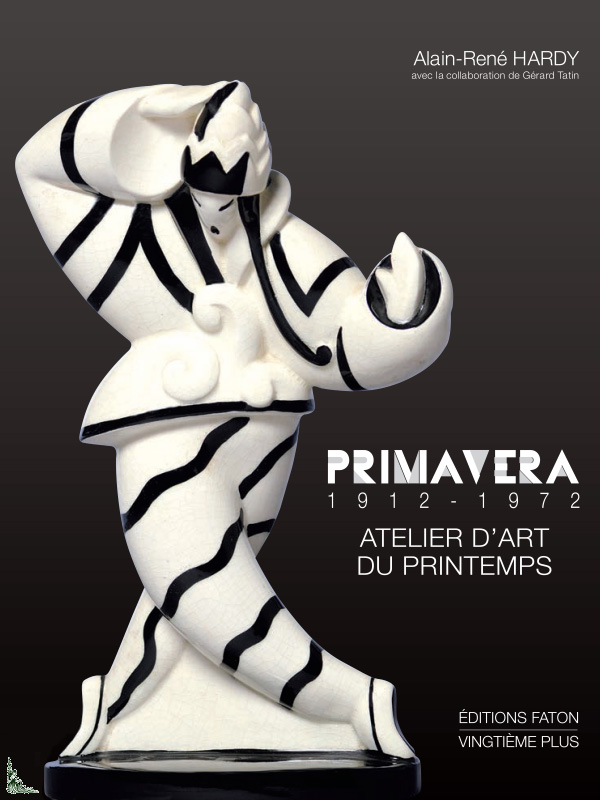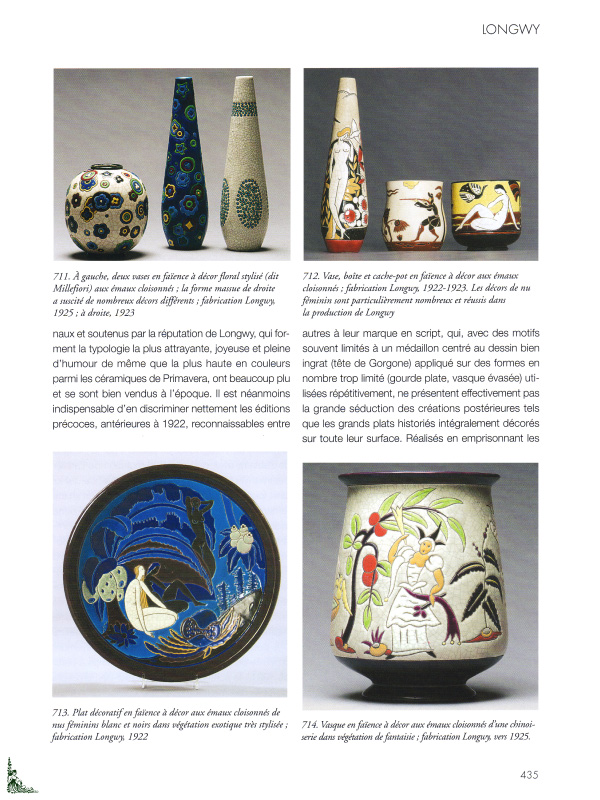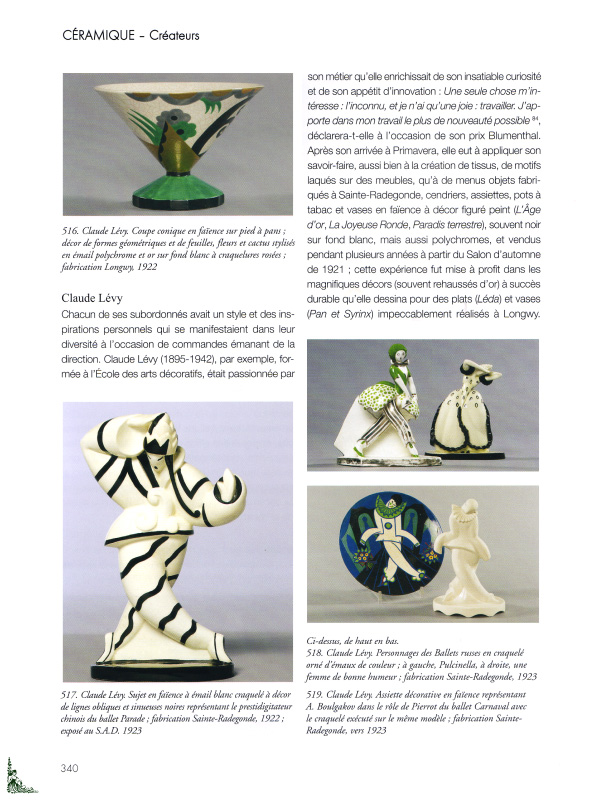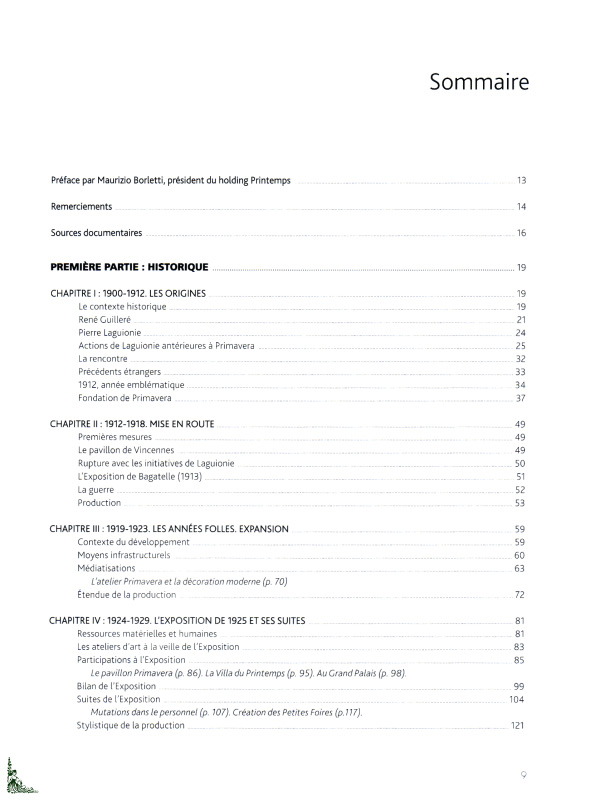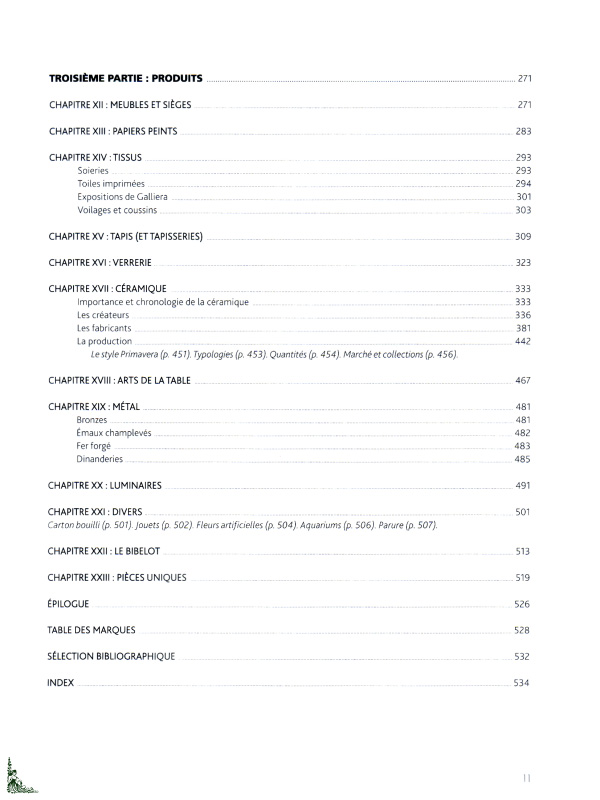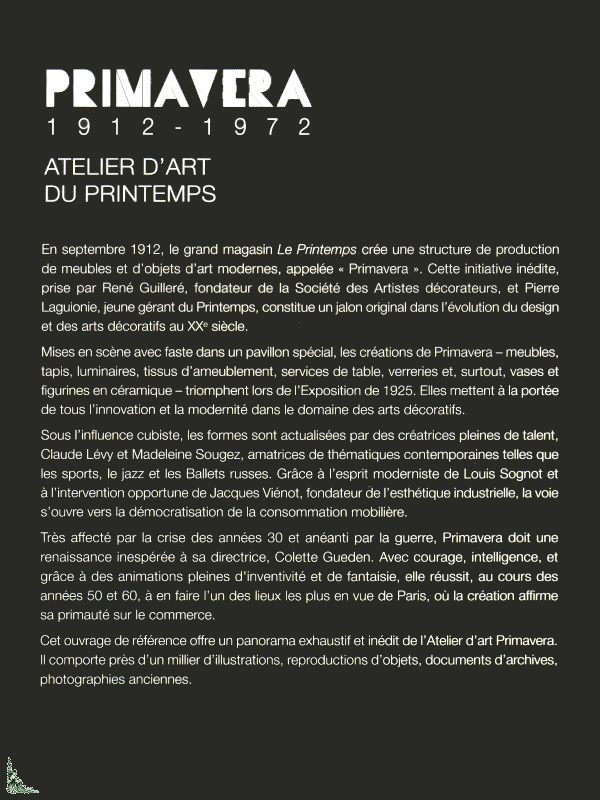PRIMAVERA 1912 - 1972 Atelier d'Art du Printemps
この本の詳細
| 著者 : | Alain-René Hardy & Gérard Tatin |
| 出版業者 : | Faton (2014) |
| 不良部分 : | Hardcover w/jacket (540 full color pages) 9 inches x 12 inches |
| 言語 : | French |
| ISBN : | 978-2-87844-182-6 |
| EAN : | 9782878441826 |
記述
PRIMAVERA 1912 - 1972 Atelier d'Art du Printemps, by A.R. Hardy and G. Tatin, Ed. Faton, 9 inches x 12 inches ( 23 cm x 30 cm ), hardcover book with 540 full color pages
This reference book of 540 full color pages provides a comprehensive and unique panorama of the "Atelier d'Art du Printemps Primavera", with nearly one thousand illustrations, reproductions of objects, archival documents, old photographs...
The initiative taken in September 1912 to grand the Printemps department store with a workshop to create and produce furniture and modern objects, named Atelier Primavera (« spring » in Italian), comprises a decisive moment in the evolution of 20th Century Design.
This was done through the will of two ardent supporters of the introduction of modernity in the decorative arts, Pierre Laguionie young manager of the Printemps department, and the lawyer René Guilleré, founder of the Society of Artists decorators.
The applied arts and all their components, furniture, rugs and carpets, lighting, furnishing textiles, tableware, glassware and, above all, ceramic vases and artworks, were lavishly presented in the 1925 Exposition Universelle in Paris, thus becoming accessible, through a powerful sales instrument, to the middle classes.
Designers are hired, a pottery was purchased in Touraine to provide part of the production, other workshops or manufactories, including the famous enamels of Longwy, are solicited in the area of glass and ceramics... Thus was born an original production.
Under the influence of talented and creative artists Claude Levy and Madeleine Sougez, and because of the modernism displayed by Louis Sognot and the timely intervention by Jacques Vienot during the next decade, the route was opened towards the democratization of consumer artworks.
Severely affected by the crisis of the 1930s and completely destroyed by the war, Primavera owed its unexpected renaissance to its director, Colette Gueden, who had joined the workshop twenty years previously, who, with her courage, intelligence and flair was to make it, with her "Fêtes du Printemps", one of the trendiest places of Paris during the 1960s.
The adventure ends in 1972, after sixty years of creations that have become synonymous with creativity and imagination.
This book includes the main marks and signatures to help identification and dating.
Contents:
Part 1: History
- 1900-1912 The origins
- 1912-1918 Start-up
- 1919-1923 The Roaring Twenties : expansion
- 1924-1929 The exhibition of 1925 and its aftermath
- 1930-1939 Crises
- 1940-1972 War and postwar
- Primavera, Art Workshop of the Printemps
- Activities
- Contributors
- Production
- Image and Communication
- Furniture and seating
- Wallpapers
- Furnishing textiles - Silks, Printed canvas, Galliera exhibition, Curtains and cushions
- Rugs and carpets
- Glassware
- Ceramic and artworks - Designers, Manufacturers, Production
- Tableware
- Metal - Bronze, Champleves Enamels, Cast Iron, Brassware
- Lighting
- Misc. - Pasteboard, Toys, Artificial Flowers, Aquariums, Sets...
- The ornament
- Unique pieces
- Table of Marks and Signatures
- Bibliography
- Index
The French texts are written by Alain-René Hardy and Gérard Tatin.
 Description française
Description française
PRIMAVERA 1912 - 1972 Atelier d'Art du Printemps
Détails du livre
| Auteur : | Alain-René Hardy & Gérard Tatin |
| Éditeur : | Faton (2014) |
| Reliure : | Relié sous jaquette (540 pages couleurs) 23 cm x 30 cm ( 9 inches x 12 inches ) |
| Langue(s) : | Français |
| ISBN : | 978-2-87844-182-6 |
| EAN : | 9782878441826 |
Description
PRIMAVERA 1912 - 1972 Atelier d'Art du Printemps, de A.R. Hardy et G. Tatin, Ed. Faton, 23 cm x 30 cm, relié avec 540 pages couleurs
Cet ouvrage de référence de 540 pages couleurs offre un panorama exhaustif et inédit de l'Atelier d'Art du Printemps Primavera, avec près d'un millier d'illustrations, reproductions d'objets, documents d'archives, photographies anciennes...
Fruit de recherches minutieuses et inédites, l'ouvrage offre un panorama exhaustif de la production et de l'histoire de Primavera, étonnante aventure artistique.
Le Printemps est le premier des grands magasins à vouloir se doter au début du XXe siècle d'un atelier de création original grâce à la volonté de deux ardents partisans de l'introduction de la modernité dans les arts décoratifs, Pierre Laguionie, jeune gérant du Printemps, et l'avocat René Guilleré, fondateur de la Société des Artistes décorateurs.
Les deux hommes fondent en 1912 l'atelier Primavera (« printemps » en italien), qui va connaître, après la Première Guerre mondiale, un développement rapide. Son but : rendre accessibles à tous des objets utilitaires ou décoratifs, à la fois beaux, modernes et de qualité.
Des créateurs sont embauchés, une faïencerie est achetée en Touraine pour assurer une partie de la production, d'autres ateliers ou manufactures, dont les fameux Emaux de Longwy, sont sollicitées dans le domaine du verre et de la céramique... Une production originale voit ainsi le jour.
Le Printemps met d'importants moyens de promotion au service de son jeune atelier de création et sa participation aux principaux Salons des arts décoratifs culmine avec l'édification du pavillon Primavera à l'Exposition de 1925 : des millions de visiteurs y découvrent des objets et du mobilier abordables et d'une esthétique nouvelle.
A une clientèle modeste éprise de modernité, Primavera fournit des tapis, des tissus d'ameublement, des papiers peints à la mode, et se spécialise dans les objets en céramique : vases, bibelots, figurines...
L'aventure se poursuit sous la houlette protéiforme de Colette Gueden et se clôt en 1972.
Ce livre inclut les principales signatures et marques pour l'identification et la datation des pièces.
Principaux chapitres de l'ouvrage :
Première partie : Historique
- 1900-1912 Les origines
- 1912-1918 Mise en route
- 1919-1923 Les années folles : expansion
- 1924-1929 L'exposition de 1925 et ses suites
- 1930-1939 Crises
- 1940-1972 La guerre et l'après-guerre
- Primavera, atelier d'art du printemps
- Activités
- Collaborateurs
- Production
- Image et communication
- Meubles et sièges
- Papiers peints
- Tissus - Soieries, Toiles imprimées, Exposition de Galliera, Voilages et coussins
- Tapis et tapisseries
- Verrerie
- Céramique - Créateurs, Fabricants, Production
- Arts de la table
- Métal - Bronze, Émaux champlevés, Fer forgé, Dinanderie
- Luminaires
- Divers - Carton bouilli, Jouets, Fleurs artificielles, Aquariums, Parure...
- Le bibelot
- Pièces uniques
- Table des marques et signatures
- Bibliographie
- Index
Les textes en Français sont de Alain-René Hardy et Gérard Tatin.


